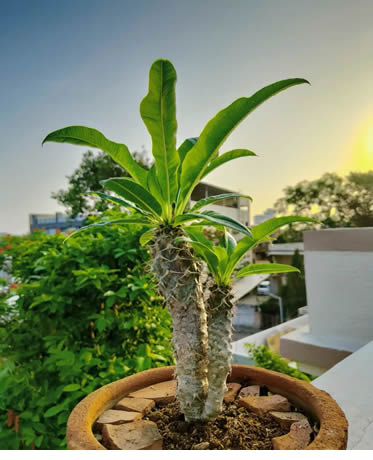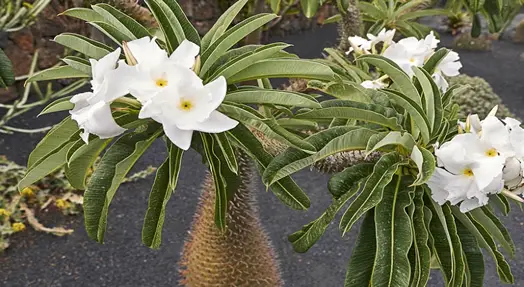Ensuring that your beloved greenery gets the love and care it needs can be quite a challenge sometimes, especially when you are dealing with a new type of plant that you’ve no experience. This is never more apparent than it is when it comes to pruning and trimming them.
Pruning can be beneficial for plant life in an assortment of ways, but methods and approaches differ and greatly depend on the type of plant species being cared for. So, should you prune your Madagascar Palms?
Table of Contents
Why you should prune your Madagascar Palms
Should Madagascar Palms be pruned?
Yes, Madagascar Palms should definitely be pruned but you must know exactly how to do it.
 There are various risks posed by pruning this plant in some cases.
There are various risks posed by pruning this plant in some cases.
However, Madagascar Palms should be pruned to assist their growth and health throughout the cause of their life.
You just have to be sure you are doing it correctly.
Many gardeners and potted plant enthusiasts will use pruning to encourage growth across all their different plant species.
In the case of the Madagascar Palm pruning not only helps stimulate foliage growth but it allows you to shape the palms to achieve the desired aesthetic look that you want as the plant continues to grow and mature.
It is similar to how Bonsai growers prune their miniature plants to growth in specific ways.
While pruning is undoubtedly advantageous for the Madagascar Palm (botanical name: Pachypodium lamerei), there are a few risks involved that you must be aware of to protect the overall health of your plant.
These risks pertain to the plant species’ traits, as this determines many of the reasons for specific approaches when pruning.
Join us as we discuss the pruning necessities of the Madagascar Palms so you are armed with the knowledge to form a practical and beneficial care routine.
How pruning affects a Madagascar Palm
The Madagascar Palm is a succulent shrub, and the name stems from its visual appearance since its physical traits resemble that of palm trees once they are fully grown.
It is actually closer to cacti than palms.
The Madagascar Palm trunk or stem typically grows to 24 ft tall. It is a fairly resilient plant and stems may branch to form foliage if injured as it grows.
Branching from the stem can be maintained by pruning, and overgrown foliage can be reduced through pruning as well.
When done correctly, pruning can be incredibly beneficial as it supports regeneration.
Many enthusiasts choose to prune their Madagascar Palms when the leaves begin to wither or turn brown due to damage.
This can happen with changing seasons, adverse weather conditions or due to a lack of water.
Some plant owners will choose to bring their outdoor Madagascar Palms indoors when the plant starts to show signs of foliage damage when colder months approach.
During harsh seasons such as winter most Madagascar Palms will benefit from being moved indoors.
For this reason you will often see outdoor Madagascar Palms in pots rather than being placed directly into the soil.
If you live in an areas where you feel that moving the palm to an indoor space during colder conditions is best, then the plant’s height needs to be taken into consideration.
If you find that your Madagascar Palm needs a lot of pruning, due to damaged foliage then it may be time to bring the plant into a warmer environment if the weather conditions are cooling.
The risks involved with pruning a Madagascar Palm
As I mentioned previously there are risks involved when pruning the Madagascar Palm and you need to be aware of them before you ever take shears to it.
Risks of pruning the Madagascar Palm typically involve the process of pruning and the timing of it.
How and when the palm is pruned is more important than usual with this species of plant.
If the plant is still young and has not been given enough time to grow to a reasonable size, it should not be pruned as it may affect its growth as it ages and matures.
Avoid pruning the palm near the trunk. If pruned at the trunk, Madagascar Palms may suffer from stunted growth.
You should never prune a Madagascar Palm more than is completely necessary.
These plants require very little pruning and much less than most other plant species.
Always wear gloves when pruning Madagascar Palms as the sap is poisonous and can cause some severe symptoms.
As I pointed out in this article Madagascar Palms contain poisonous say that if ingested can cause some horrible side-effects.
But ingestion isn’t the only delivery system this succulent has evolved to use.
Even a small puncture from 1 spike can cause a severe reaction in some people.
Wearing appropriately thick gardening gloves will protect you from the spikes.
Be aware that Madagascar Palms also pose a real risk to pets, especially cats who tend to be more curious and more likely to eat the leaves.
See the article are Madagascar Palms poisonous for more information on how this succulent can adversely affect humans and animals.
You may also want to read the article on pet safe plants.
How to prune a Madagascar Palm correctly
You should prune Madagascar Palms at the top when they are overgrown or become too tall for the available area.
Pruning the palm assists regeneration by encouraging the growth of fresh foliage.
Pruning also stimulates healthy blooming when done correctly.
However, Madagascar Palms should not be pruned at the trunk.
When pruning a Madagascar Palm you should use a sterile knife or good quality sharp pruning shears will usually suffice for most palms though you may need a saw depending on the size and shape of the Madagascar Palm.
The sterilization of the pruning tool is essential, as this will prevent any disease being introduced to the cut site and then spreading to other areas of the plant.
More often than not gardeners will not worry that much about sterilizing cutting tools while pruning but this is a mistake.
Of course you could go years without it having any negative effect. But trust me, when a lack of sterilization introduces disease to even just one your beloved plants you’ll regret not having formed this simple, quick and easy routine.

This is especially true if you end up losing the plant … and it will happen eventually without the correct care!
Although I have used a range of different products to sterilize my garden tools over the years I have recently started to use simple sterilization wipes.
These wipes are cheap, convenient and do the job without having to mix a solution and add it to a spray bottle before spraying and clearing the tools.
A few wipes and the job is done.
It also makes it easy to wipe the tool when moving from one plant to another thus ensuring any potential problems with one plant never get transferred to another due to my actions.
The Madagascar Palm should always be pruned from the top to achieve the desired height.
Cutting at the top of the plant severs the leaf spiral center, which encourages new foliage growth from this area.
Just be aware that regrowth will take time with this plant. It may take a few weeks before regrowth begins to show and a few months before the regrowth is clearly evident.
Thus, another good reason to avoid pruning unless completely necessary.
You should therefore only attempt to prune this plant if it is overgrowing or is becoming too large for the available area.
Pruning helps encourage beautiful Madagascar Palm blooms
So, we have seen that pruning the Madagascar Palm will help encourage new foliage growth but what blooms?
Matured Madagascar Palms bloom with fragrant flowers. The flowers grow on the outside of the stem and are approximately 4″ across.
They can be red or pink or more commonly, white with a yellow pistil at the center.
Young plants rarely bloom and indoor plants will only bloom if they have access to plenty of direct sunlight.
A mature Madagascar Palm will bloom abundantly when it is healthy and happy, coupled with an annual growth rate of approximately 12 inches.
Mature Madagascar Palms will form fragrant flowers on the outside of their stems that can be white, pink or red.
The age of the plant determines if it blooms or not as young Madagascar Palms rarely bloom.

Ensuring that all of the plant’s care needs are met, including appropriate pruning, will encourage blooming.
A lack of blooming in the summer months may indicate that the plant’s care plan needs to be adapted somehow ensuring that it gets plenty of direct sunlight.
Being a succulent the Madagascar Palm will thrive in direct sunlight and plenty of sunlight is absolutely essential if you want the plant to bloom.
Lack of direct sunlight is almost always the cause of lack of blooms on indoor Madagascar Palms.

